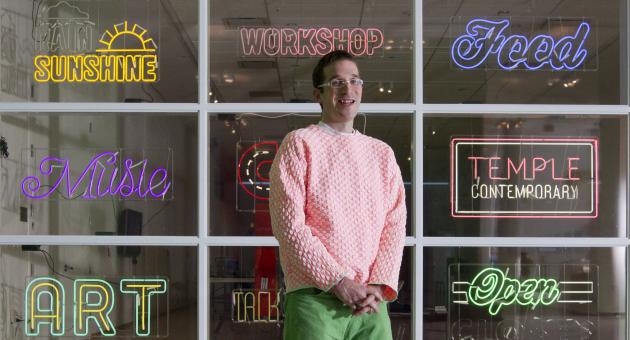Temple Contemporary's leading light
A new name, a fresh approach and record numbers of visitors for Tyler's flagship art gallery

Since he came to Temple's Tyler School of Art a year and a half ago, Robert Blackson, Tyler's director of exhibitions and public programs, has been turning art gallery convention on its head.
To see the latest evidence, just walk into the atrium of Temple's Tyler School of Art or peek through the building's façade. Covering the front of Temple Contemporary — the new name for Tyler's flagship exhibition space, once known as Temple Gallery — is a new, 12-by-20-foot, 11-color grid of neon signage. Each space in the grid is filled with a word or two: "Workshop," "Food," "Music," "Art," "TalkTalkTalk" and more. All Blackson needs to do is flip the switch depending on the day's programming, and passers-by know what's on the menu.
The new approach doesn't end there. Walk through Temple Contemporary's front door, and you're just as likely to find a debate on journalistic partisanship, a portable book-publication studio, a meal of plants foraged in the neighborhood, a panel discussion on Philadelphia's public schools or a living beehive as you would an installation of paintings, drawings, sculpture, prints or photographs. Behind the scenes, invisible to visitors, Blackson is exploding another gallery norm. Instead of developing programming on his own, he relies on advisory councils made up of students, community leaders and faculty members in fields ranging from science to the humanities to generate ideas that are directly related to issues of the day.
Blackson is part of movement of young curators who have "shifted their focus to the community" and "thrown a wrench into the traditional, top-down model of exhibition-making, in which curators place art in a room and everyone else scrambles to make sense of it," wrote the Philadelphia Weekly last year. It's a seismic shift for the local art scene, and Temple is at the epicenter. The new approach is causing a buzz and building new audiences. Gallery visitation tripled in 2011 compared to the previous year, and 2012 is on track to break last year's record.
"When you come to Temple Contemporary, we want you to participate in the artistic process," said Blackson, who previously served as curator of public programs at Nottingham Contemporary in the United Kingdom. "Whether you're coming to make a cup out of Marcellus Shale or you're learning about accents across the country, we want people to be physically engaged."
The process of participation begins with Temple Contemporary's three 10-member advisory councils: one made up of Temple students, another made up of Philadelphia community leaders and thinkers (with a special emphasis on North Philadelphia) and a third comprising Temple faculty members and administrators. Blackson convenes each panel at least once a semester, asking each member to bring an unanswered question "that is locally relevant and internationally significant." Blackson and Temple Contemporary Assistant Director Sarah Biemiller stoke the discussion, take notes, solicit voting and compile feedback. Then they take the questions that receive the most votes or interest among the councils and begin to formulate exhibits and programming that address those questions.
"The question I ask myself when I go into a gallery is: 'Why are we looking at this now?'" Blackson said. "When you name an exhibition facility 'Temple Contemporary,' it foregrounds the idea of what is meaningful to us now. It's a big question. It's not something that an individual art curator can responsibly address, at least not alone. So I turn to the communities that surround us — Temple, North Philadelphia and beyond — and I rely on the advisory councils."
Among the dozens of installations and events at Temple Contemporary in the coming month are hands-on candy-making demonstrations (an idea that emerged from an advisory council discussion about Philadelphia's production-economy heritage); a machine that tests visitors' recognition of regional accents (inspired by the work of local linguist William Labov, who spoke at the gallery in September); and a recreation of the prison cell of Herman Wallace, an inmate who has spent more than three decades in solitary confinement (part of a year-long exploration of incarceration).
Even Temple Contemporary's art labeling process is participatory and ultra-local. Instead of printing labels, Blackson has hired Tyler student Bartholomew Lyons, a graphic and interactive design student and a talented calligrapher, to hand-write all the gallery's labels using pokeberry ink — the same type used on the Declaration of Independence — made from pokeberries harvested in North Philadelphia.
"At Temple Contemporary," Blackson said, "we're not just showing things, we're making things meaningful."